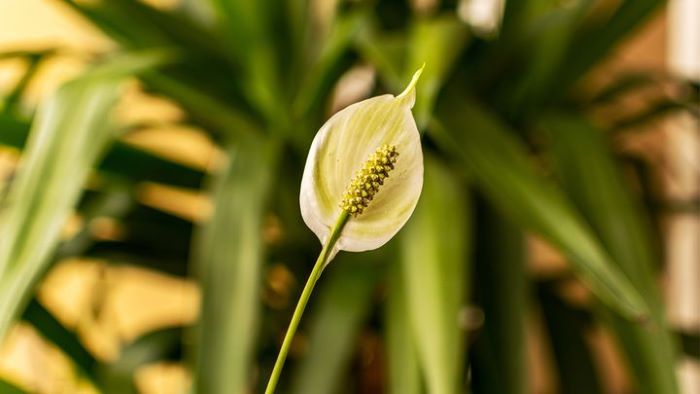When looking to add some greenery to your home, pothos and peace lily plants are two great options to consider. Both are popular, low-maintenance houseplants that can thrive indoors with minimal care. But there are some key differences between these plants that are worth noting when deciding which one is the better fit for your space. In this article we talk about Pothos vs. Peace Lily – Which Plant Fits Your Home in 2024.
Table of Contents
Appearance and Size

In terms of appearance, pothos and peace lily plants have quite different looks.
Pothos features broad, waxy green heart-shaped leaves with yellow or white variegation. The leaves emerge singularly from trailing or climbing stems. Pothos can grow quite long when left unchecked, with trailing stems reaching 10 feet or more in ideal conditions.
Peace lilies have lush, deep green oval-shaped leaves that emerge in a rosette shape from a central stalk. The leaves can reach up to 65 cm in length. When peace lilies bloom, they produce slender white flowers that rise directly up from the soil on tall stems above the foliage.
So in general, pothos has more of a vining habit with longer dangling stems, while peace lily has an upright, compact form factor with lush foliage and unique flowers.
In terms of size, how big these plants get depends on the conditions. In their native tropical climates, both pothos and peace lily can grow quite large, even up to 10 feet tall. But when grown as houseplants, they tend to max out at a smaller, more manageable size.
Pothos can thrive in a small pot or hanging basket for years, growing long trailing vines. Peace lilies also do well in a 6 inch or 8 inch pot, growing up to 2 feet tall and wide indoors.
So if size is a concern for your space, both plants can be maintained small with regular pruning and repotting. But pothos may require a bit more maintenance to keep its long vines under control.
Light Requirements
When it comes to lighting conditions, peace lily and pothos have similar preferences for indirect sunlight.
Pothos does best in bright, indirect light. Direct hot sunlight will scorch its leaves, but it can tolerate low light conditions quite well too. The variegated varieties need a bit more light to maintain their white or yellow coloring. In low light, the leaves will revert to solid green.
Peace lilies also prefer bright, indirect sunlight and will tolerate low light. Too much direct sun will damage their foliage. In lower light conditions, peace lilies may bloom less frequently.
So both plants are fairly flexible when it comes to lighting needs. Just avoid placing them in direct sunlight or intense heat sources like vents or radiators, which can damage their foliage. Peace lilies may need a brighter spot to encourage blooming.
Watering and Soil Needs
When it comes to their soil and water preferences, pothos and peace lily share some similarities but also have a few differences.
Well-draining, fertile potting mix is ideal for both plants. Enriching the soil with compost or fertilizer will encourage faster growth.
For watering, it’s important not to overwater either plant as they are both susceptible to root rot in soggy soil. Allow the top inch or two of soil to dry out between waterings. Pothos prefers to dry out a bit more between waterings compared to peace lilies.
Peace lilies often wilt dramatically when thirsty, even if the soil is still slightly damp. So it’s important not to confuse this temporary wilting with permanent drooping from overwatering. Feel the soil before watering peace lilies when they show signs of thirst.
As tropical plants, both pothos and peace lilies enjoy increased humidity. Mist both plants regularly or use a pebble tray to provide a humidity boost.
So in summary:
- Use fast-draining, nutrient-rich potting mix
- Allow soil to dry out between waterings
- Pothos tolerates drier soil than peace lilies
- Peace lilies wilt when thirsty even if soil is slightly damp
- Mist plants or use pebble trays to boost humidity
With their shared tropical origins, both plants thrive in warm temperatures between 60°F to 85°F. Avoid exposing them to cold drafts or allowing the roots to become chilled.
Ease of Care
One of the reasons pothos and peace lily plants are so popular is they are fairly easy to care for compared to other houseplants. However, pothos requires slightly less maintenance overall.
Pothos is almost indestructible under the right growing conditions. It tolerates low light, inconsistent watering, and a wide temperature range quite well. And it requires little pruning unless the vines become overly long and tangled. This adaptability makes it one of the easiest indoor plants to grow.
While peace lilies are also simple to maintain for beginner plant owners, they are a bit more particular about their care needs. Their drooping leaves demand more attentive, consistent soil moisture. And their lush foliage requires grooming to maintain their appearance.
So for the most hands-off, low maintenance plant, pothos edges out the peace lily when it comes to ease of care. Peace lilies do require a bit more attention, but are still a great option for plant novices compared to trickier species.
Pet and Child Safety
An important consideration when bringing plants into your home is safety around children and pets. Fortunately, both pothos and peace lily plants have low toxicity levels. However, pothos is the safer choice for homes with curious kids or pets.
Pothos is considered non-toxic to both cats and dogs. If chewed or ingested, it may cause temporary irritation like vomiting or drooling but is unlikely to do serious harm.
Peace lilies contain calcium oxalate crystals that can cause mouth and stomach irritation and inflammation if chewed or eaten. The level of toxins is relatively mild compared to other common houseplants, but ingestion can still result in nausea, vomiting or difficulty swallowing for pets or kids.
So for homes with pets or small children who may be tempted to chew on the foliage, pothos is likely the safer pick over peace lily. As always though, keeping plants out of reach of young kids and pets whenever possible is advised.
Air Purifying Ability
One benefit of bringing plants indoors is their natural ability to purify the air by absorbing pollutants. In this regard, peace lily plants outperform pothos.
Studies by NASA and others have found peace lily to be one of the top houseplants for removing all three major indoor air pollutants – benzene, formaldehyde and trichloroethylene. These toxins are released from sources like furniture, cleaning products and more.
While pothos is great for providing visual interest and easy care, it has only a moderate ability to purify indoor air. So if cleaner indoor air is a priority, peace lily is the better choice. Position several peace lily plants around rooms where you spend the most time at home or sleep.
Cost and Availability
When it comes to cost and availability, pothos and peace lily are both quite affordable and easy to find. You can purchase small starter plants at most garden centers, big box stores, grocery stores and online for just a few dollars.
Peace lily may have a slightly higher price tag for larger or blooming specimens. But both offer great value considering how long they live indoors with proper care.
In terms of availability, pothos may have the edge thanks to its vining growth habit. Just by taking cuttings from a parent plant, new pothos babies can be propagated infinitely. So you can easily multiply your pothos collection or share cuttings with friends. This gives pothos the ability to spread readily.
While not as adept at propagation, peace lily can also be divided to produce new plants relatively simply. So both plants provide opportunities for new growth without a major investment.
The Verdict: Which is Better for Your Home, Pothos or Peace Lily?
So when considering the key differences between these popular houseplants, which one makes the better fit for your living space?
If you’re simply looking for an easy care plant that requires minimal maintenance, pothos is likely the better choice. With its resilient nature, flexibility with lighting and watering, quick growth from cuttings and low toxicity, pothos is one of the simplest indoor plants to grow. Trailing pothos vines also provide beautiful draping foliage to decorate shelves, desks, and tabletops.
On the other hand, if you want a plant more tailored to purifying indoor air, peace lily is the way to go. With its incredible ability to filter out major pollutants, peace lily can actively improve the air quality in your home. Its elegant blooms and lush foliage add a touch of sophistication and beauty to any room. Peace lilies do require a bit more attention to keep their soil consistently moist and their leaves looking their best, but the air-purifying benefits and the potential for stunning blooms can make it a worthwhile choice.
In summary, both pothos and peace lilies offer unique benefits and can enhance your indoor environment in different ways. Consider your priorities: if ease of care and a resilient plant are what you need, pothos is the perfect fit. If you’re looking for a plant with air-purifying abilities and don’t mind a bit of extra care, peace lily is a fantastic option. Ultimately, the best choice depends on your specific needs and preferences for indoor plants. I sincerely hope you find this “Pothos vs. Peace Lily – Which Plant Fits Your Home in 2024?” article helpful.

